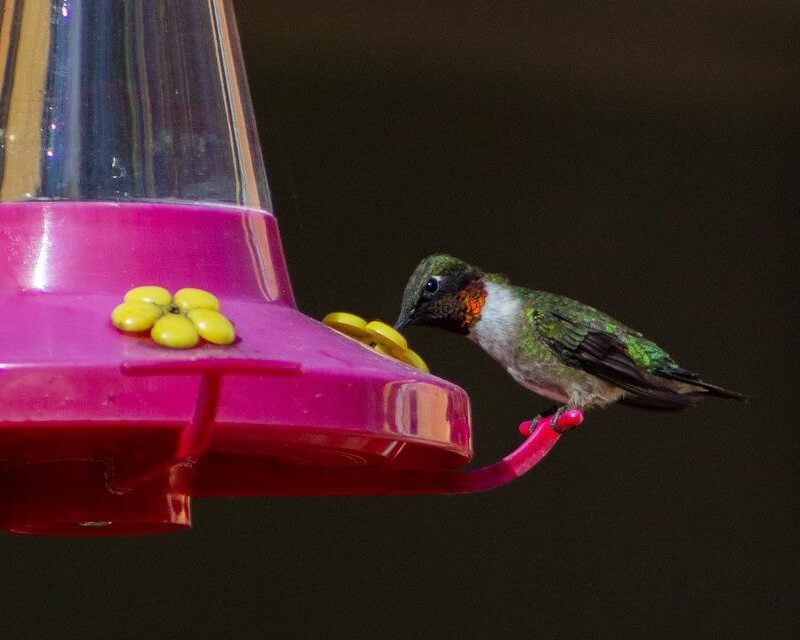Vermont is a beautiful state located in the northeastern United States, known for its lush green hills and picturesque mountain views. It is also home to a variety of wildlife, including a wide array of hummingbirds. These small, colorful birds are a delight to watch as they float from flower to flower. In this article, we’ll explore the different types of hummingbirds found in Vermont, their habitats, and how to attract them to your backyard. So, if you’re a nature enthusiast or just curious about the birds of Vermont, read on to learn more about the common hummingbirds of Vermont.
Hummingbirds in Vermont
Read on to learn more about the 3 hummingbirds that visit Vermont.
Mexican Violetear

- Colibri thalassinus
- Size: 4.5″ (12 cm)
Identification and Color: Also known as the Green Violetear, they are mostly green hummingbirds. They have green and blue iridescent colorings on their bodies. A blue-purple iridescent patch is found on their cheeks. Wings and tail feathers are darker.
Habitat and Behavior: Found in south-central Mexico and as far south as Panama and Bolivia. They like semi-open highlands with trees or shrubs and prefer humid areas. Will visit the United States but not breed there.
Diet: Nectar is their primary diet, but they may also eat some small insects.
What does a Mexican Violetear sound like?
Mexican Violetear (Colibri thalassinus) · song
Manuel Grosselet
Paz de las Aves, Pichincha, Ecuador
More Mexican Violetear Facts
Ruby-throated Hummingbird

- Archilochus colubris
- Size: 3.5″ (8 cm)
Identification and Color: The Ruby-throated Hummingbird has a brilliant green color on the tops of their heads and bodies and a grey to white underpart. The males have a red throat that can appear dark in poor lighting. A small bird between 2 and 3.5 inches in length. They also have very short wings. A long, slender slightly curved bill.
Habitat and Behavior: In the summer they are found throughout the midwest and the eastern United States but almost all leave for the winter. The Ruby-throated Hummingbird prefers open woodlands, meadows, and gardens. They can fly very fast and will forage from flowers or feeders.
Diet: Mostly nectar from flowers but will eat some small insects.
What does a Ruby-throated Hummingbird sound like?
Ruby-throated Hummingbird (Archilochus colubris) · uncertain
Brian Hendrix
Hendrix Habitat – Fairview, Williamson County, Tennessee, United States
More Ruby-throated Hummingbird Facts
Rufous Hummingbird

- Selasphorus rufus
- Size: 3″ (7.5 cm)
Identification and Color: A smaller hummingbird with short wings, tapered tail feathers, and a straight bill. Males are bright orange with an iridescent red throat and white underparts. Females are green on top with duller orange colors.
Habitat and Behavior: Commonly breed and migrates to the western United States but may also spend winter months in the southeast. Exceptionally fast flyer and will often chase away other hummingbird species from food. Prefers open areas like yards, gardens, or edges of forests.
Diet: Prefers red tube-like flowers for nectar. It also eats tiny insects like spiders.
What does a Rufous Hummingbird sound like?
Rufous Hummingbird (Selasphorus rufus) · call, shuttle display, wing whirr
Eric DeFonso
Twin Spruce Rd area, Jefferson County, Colorado, United States
More Rufous Hummingbird Facts
Conclusion
Hummingbirds in Vermont have captivated the hearts of many in the state, and it’s easy to see why. These tiny birds are a symbol of life and joy, and their presence in the state is a reminder of the beauty of nature. The hummingbirds’ ability to migrate and adapt to their environment is a testament to their resilience and strength. As the climate continues to change, it is important to remember that these birds are a part of our natural world and should be protected so they may continue to thrive in the Green Mountain State for generations to come.
Before you go, be sure to check out our other articles about birds in Vermont.






